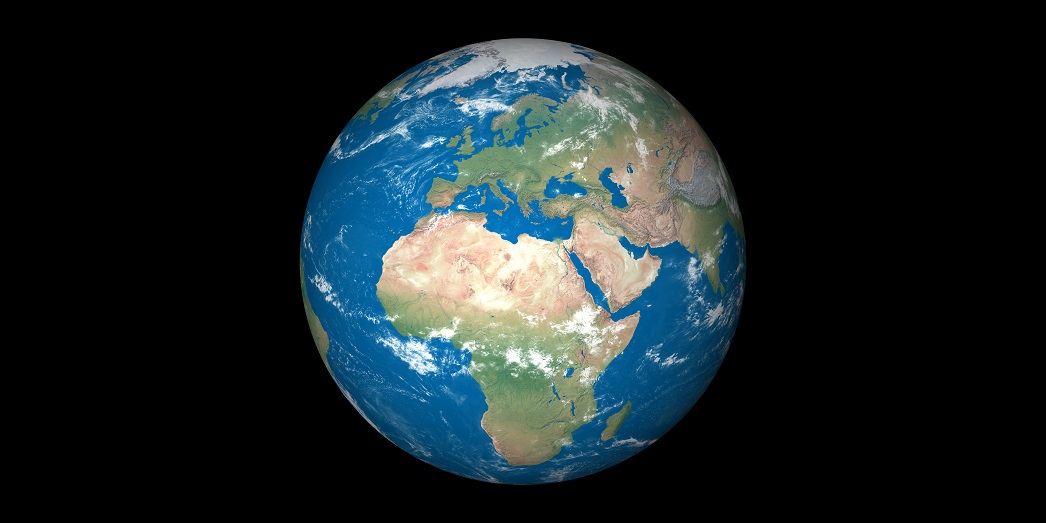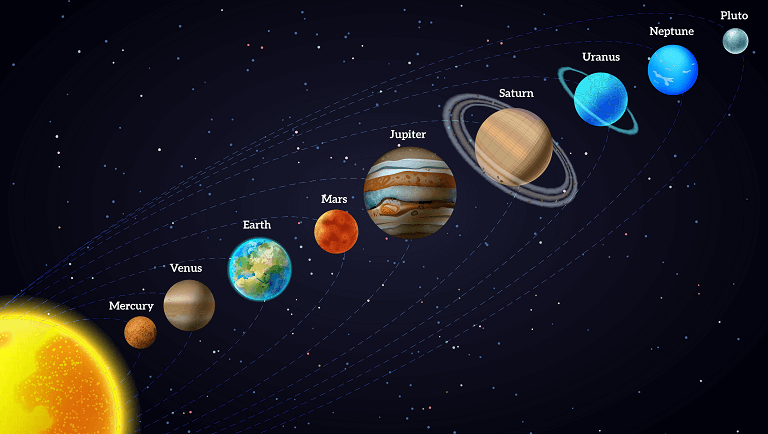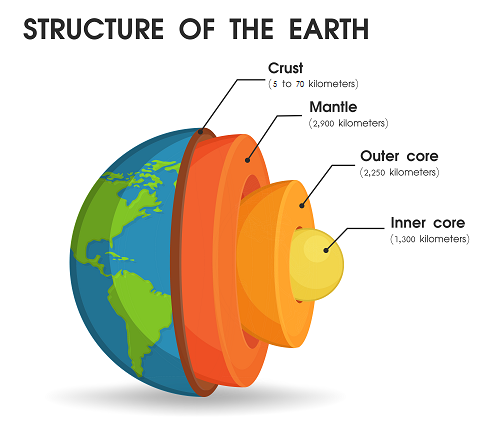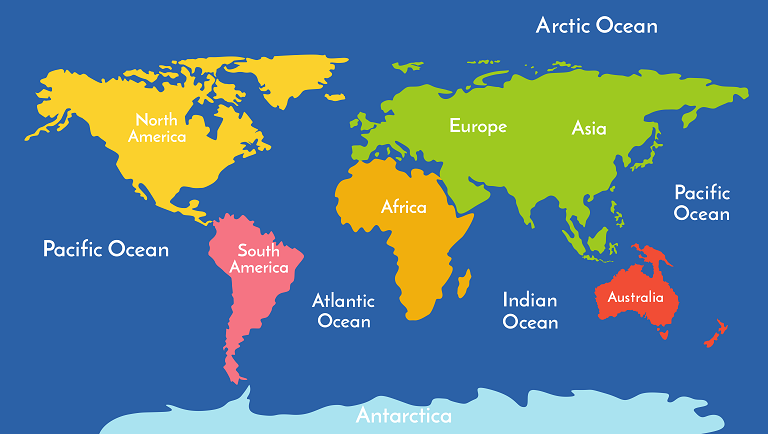
Earth for kids: 20 amazing facts about our planet
The Earth is fantastic, beautiful, mysterious, and genuinely unpredictable. We know so much about it and so little in the meantime. We can hold the entire globe in our hands (even as a geographical ball), but there is not enough life to visit every place on it.
Well, our planet still holds many mysteries. And those discoveries about the Earth that have long been public knowledge, we proceed to be surprised even now. Here are some fascinating, exciting facts about the beautiful terrestrial planet.
Fact 1. How far is Earth from the Sun?
Earth is the third planet from the Sun. People know the Earth as the entire planet with an atmosphere of oxygen, intelligent life, and vast expanses of water. You should clearly understand that the average range between our planet and the Sun is almost one hundred and fifty million kilometers!
If a person had the theoretical possibility to walk to the Sun, he would have reached it only after three and a half thousand years later! And it is just in the case that it would be without any stops.
It is worth noting that the best neighbors of the Earth are Venus, Mars. Nevertheless, Venus is the nearest to our planet.
Fact 2. Dimensions
Many people aren’t aware that the Earth does not have an ideal rounded form. Due to the imbalance of gravitational and centrifugal efforts in the equator line’s territory around the planet, there is an insignificant bulge.
As the greatest, the Earth has an alleged weight of 5.9722±0.0006×1024 kg. Its size is also the biggest of these planets and is 1.08321×1012 km3.
Among other things, the Earth is the tightest of the terrestrial planets because it consists of elements such as the bark, mantle, and kernel.
The globe can be characterized as the greatest among the other planetaries in our star system in concepts of circumference and dia. So, for example, the rim of the equator is 40,075.16 km. Nevertheless, it is marginally shorter between the North and South Poles. The EarthEarth’s diameter at the polar is 12713 km, and at the equator line is 12756 km.

The circumference and diameter differ in that its shape is an oblate spheroid or ellipsoidal rather than a real circle. It is quite evident that the Sun is larger than the Earth in radius by more than 100 times, in mass by 333 thousand times. You need such information to represent the scale.
So, let’s say, in comparison, the Earth has a similar scale to Venus, but Mars, in turn, is half as small.
Fact 3. What does “Earth” mean?
In English, the name of our planet takes its origin from the Anglo-Saxon word «erda» («earth»). Most likely, Nicolaus Copernicus was the first to name the Earth in the 15th century, who proved that the center of the framework is the Sun, not the Earth. On the pedestal of the monument to Copernicus in Warsaw, it is written: «He stopped the Sun and moved the Earth.»
In astrology, it is customary to use Latin names to refer to the planets. And in this language, the name of our home is pronounced as Terra, which means «soil». Being primarily an earthly being, man could only call the place where he lived by analogy with the soil under his feet.
Fact 4. Movement around the sun
The Earth advances in its trajectory around the Sun. The rate of movement is 30 km/s. The Earth moves in the identical direction as it rotates on its axes. The range from the Earth to the Sun is about 150 million kilometers. The Earth makes one turn around the Sun in a year — 365 days and six hours. Thus, it appears that in 4 years, another day runs up. Therefore, every fourth year in February, not 28 days, but 29.
Due to the tilt of the axis, the Earth, spinning around the Sun, replaces it with its northern and southern parts. This is how the seasons change.
Fact 5. Why do we have day and night?
The Earth, spinning around its axis, turns the immediate cause of the Sun, illuminating a particular part of the land. Thus, there is the change of daytime and night.
Our planet makes a whole turn around its axis in a day (or twenty-four hours). It is also worth noting that the Earth spins from west to east, counterclockwise, if we look at the Terra from the North Pole.
Fact 6. What is gravitation?
So, what is «gravity»? Gravitation represents the effort by which planetary and other bodies reason objects to be pulled to their center. Simply put, if it weren’t for gravity, we would have flown into space instead of being attracted to the surface of the globe. Thus, all the planetaries located in the star system feel the direct attraction of the Sun and are in their places.
The effort of an attraction may differ, as it relies directly on the mass of objects and the distance between them. It is worth paying special attention to the fact that everything that has weight also has gravity. Gravity becomes weaker with long-range. But the closer the objects are, the more there is gravity. Isaac Newton was the first to describe gravity mathematically, saying that gravity affects absolutely all objects identically. This is how the law of universal gravitation was created.
Fact 7. Why is there life on Earth?
Today, the Earth is the only planet known to us, inhabited by living, intelligent beings. Earth life is the only form of life that we know. From here, we can conclude that life in space requires water in liquid form. Since it is thanks to the water, there are various biochemical reactions.
Such conditions in the solar system can only be seen on our planet. For example, if Venus is too close to the Sun, the planet’s surface becomes incredibly hot. Because of this, the water on it turns into steam. In turn, Mars is located at an unnecessarily large distance from the Sun, the water freezes.
The Earth has the most favorable location for the possible functioning of living beings. The planet has the required density, is moderately warm so that the water does not freeze. But also moderately cold, that is, the water will not evaporate. In addition to all the above, the Earth has a satellite that promotes the regulation and stabilization of climatic conditions, as well as a particular magnetic field and atmosphere that help protect living beings against radiation.
Fact 8. Structure of the Earth
It should be noted that the Earth has a layered structure. There are three large layers:
- the Earth’s crust,
- the mantle,
- the core.
The deeper you get inside the globe, the greater the pressure and temperature will become. The center of the Earth is the core with a radius of three and a half thousand kilometers. The temperature here, in turn, is four and a half thousand degrees.

Around the core is the mantle. The thickness of the mantle is about three thousand kilometers. On top of the mantle is the Earth’s crust, the thickness of which can be equal to five kilometers or even reach up to seventy. The Earth’s crust is the hardest and strongest shell of the globe. The substance of the mantle is continuously in motion and can slowly flow over.
Fact 9. What does our atmosphere consist of?
The atmosphere of the globe is formed by a certain number of layers of gases, which, in turn, make up our planet’s environment under the influence of gravity.
Each of the layers of the atmosphere has a unique composition and structure. Their gradation is formed according to their density. Thus, the densest gases are nearest to the Earth’s plane, while the rest are distant from the planet at a distance that depends directly on their density.
Due to the many various features that describe gases, all atmospheric layers have a significant, unique role in the implementation of life on Earth.
You should remember the names of the five layers that make up the atmosphere of the globe:
- the Troposphere;
- the Stratosphere;
- the Mesosphere;
- the Thermosphere;
- the Exosphere.
Fact 10. About the Moon
As you probably already know, the Moon is the only natural satellite of our planet. Among other things, the Moon is the second brightest celestial body. In the process of the Moon’s rotation around the Earth in a monthly time interval, the angle between the Sun, the Moon, and the Earth changes, so there is a changing cycle of lunar phases.
Even though the Moon rotates on its axis, it is always turned to our planet exclusively on one side. Tides, it is worth noting, occur due to the activity of the Moon.
Some scientists claim that the Earth once had two moons.
Fact 11. The planet of water
Water is the most critical resource, without which the existence of all living things is impossible. Scientists are convinced of the following fact: water arose only after the formation of the Earth itself. There are also versions according to which water hit our planet because of ice-covered meteorites.
Our planet is quite often called the Planet of water or the Planet of the ocean. In addition to oceans, seas, rivers, lakes, and other things, it is essential not to lose sight of glaciers. Thus, three-quarters of the globe is occupied by water, that is, about seventy-five percent.
Unfortunately, against the background of significant changes in climatic conditions, the planet is rapidly losing its water reserves. So, for example, from 2004 to 2009, the stock of ice decreased by forty percent.
Fact 12. Continents and oceans
On the territory of the globe, there are two most significant groups of objects: oceans and continents. In total, there are four oceans and six continents on the territory of our globe. Each of them is unique in its way, is special.
Usually, our planet is partitioned into two hemispheres: the northern and the southern. This division occurs with the boundary along the equator line.

The following continents are usually distinguished:
- North: North America, Eurasia;
- South: South America, Antarctica, Africa, Australia, Oceania.
Among the basic and most important characteristics of the world, the ocean is always called that it is one and indivisible. It is important to understand what exactly «indivisibility» means here. The world’s ocean is huge, and all the existing borders on its expanses are, in fact, conditional. However, for convenience, we partitioned the water space into oceans, seas, and so on. So, there are only four oceans on Earth: the Indian, Arctic, Pacific, and Atlantic. Each of them has its peculiar features.
Fact 13. How old is the Earth?
Scientists are convinced that it took about two billion years for the galaxies to become what they are now after the big bang. Their development and formation took a significant amount of time. However, according to other points of view, the solar system itself appeared only after eight billion years.
There were skirmishes between the particles, constant collisions, and gradually the Sun and the planets formed. So, the Earth formed about four and a half billion years ago. Scientists suggest that, at first, the particles were attracted electrically. After a long time, a heavy center was formed, which was the future center of our planet.
Fact 14. Climate zones
Scientists have determined the classification of climate zones, so there are seven main and six transition zones. The division into climatic belts is truly necessary since different zones produce different amounts of solar heat, the water cycle occurs differently, and due to other factors.
The list of basic climate zones will look like this:
- equatorial,
- tropical (two),
- temperate (two),
- polar (Arctic and Antarctic).
In the space of these belts, the same unified air front is located all year round.

Scientists have decided to determine the existence of intermediate climatic zones as climatic conditions change gradually. For this designation, «sub» is added to the names of climate zones. The following zones are obtained: subequatorial (there are two of them), subtropical (there are also two of them), and subpolar, which can be divided into subarctic and subantarctic.
Many factors influence climate change. Among them, some geographical conditions can be mainly distinguished: human activity and the results of this work, factors in space, the volume of air in the atmosphere, the mass of air, a long distance from large bodies of water, mass and size of the Earth, the currents in the sea, the size of continents, the size of the oceans and so on.
It is normal for the climate to change frequently. Besides, most of the changes are now caused by the human and his activities, which, in turn, significantly increases the percentage of carbon dioxide in the atmosphere.
6 more interesting facts about Earth
- The hottest temperature is recorded in the Libyan city of Al-Aziziya. So, in 1922, a record of 57.8°C was set here. And, as you know, the coldest place in Antarctica. Here, in winter, the temperature can drop to minus seventy-three degrees. The lowest temperature level was recorded there in 1983 and was equal to -89.2°C.
- The most elevated point in the world is Mount Everest. As you know, the height of this mountain is 8848 meters. Among other things, this mountain is quite often called Jomolungma or Sagarmatha.
- The deepest depression in the vastness of the world ocean is the Mariana Trench, which is settled in the western Pacific Ocean at a depth of almost eleven thousand meters.
- The most extended mountain range on the territory of our globe is located under the water column. The extent of this ridge is sixty-five thousand kilometers.
- The lowest point compared to sea level is between Israel, Jordan, and the West Bank. This is where the Dead Sea is settled.
- There are scientists with a rather unusual opinion: they are convinced that many annum ago, the surface of the Earth was not green with blue colors but seemed purple because of the extraordinary bacteria that lived on it.
We hope that you have learned a lot from this article because our planet is truly amazing, and it is even more interesting to explore it!

new engaging articles



